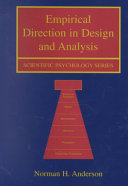
Empirical Direction in Design and Analysis
By - Anderson, Norman H.
Floor
-
Floor 1
Published
-
L. Erlbaum, Mahwah, N.J., 2001
ISBN 10 - 080583978X
ISBN 13 - 9780805839784
Book Status
-
1 Qnty Available with us.
Shelf No
-
10
Call Number
-
150.1519 AND
Physical Description
-
xv, 862 pages : illustrations ; 24 cm
Notes
-
Includes index